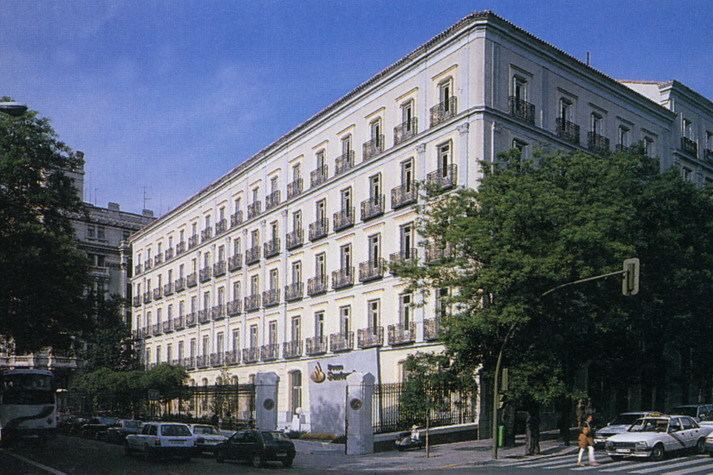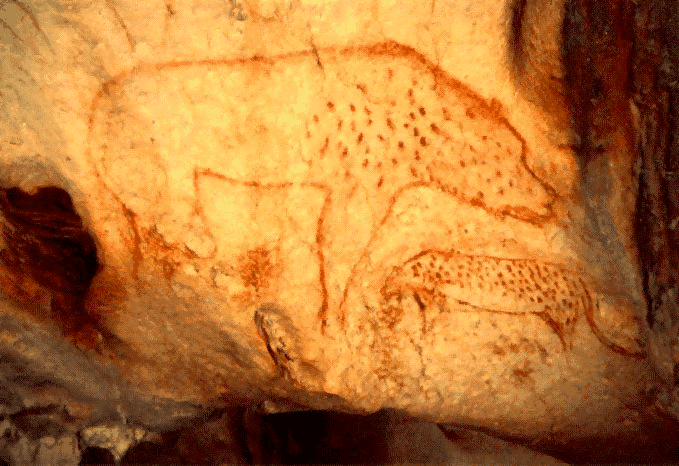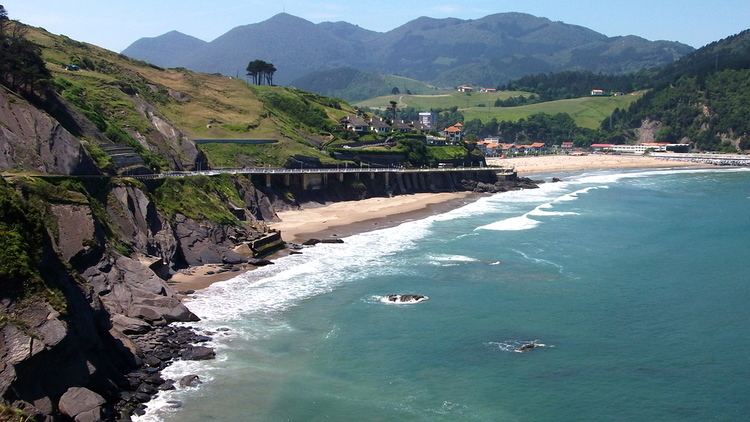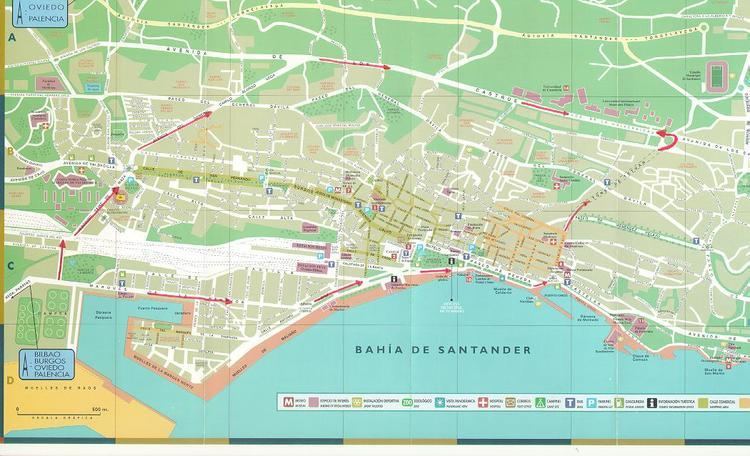Country Population 178,465 (2012) Language spoken Official website Area 35 km2 | Founded 26 BC, as Portus Victoriae Iuliobrigensium 9 January 1755, granting the title of city | |
Points of interest Magdalena Peninsula, Gran Casino del Sardinero, Bay of Santander, Palacio de la Magdalena, Santander Cathedral | ||
The port city of Santander ( ) is the capital of the autonomous community and historical region of Cantabria situated on the north coast of Spain. Located east of Gijon and west of Bilbao, the city has a population of 178,465 (2013).
Contents
- Map of Santander Spain
- Amazing places in europe santander spain
- History
- Geography
- Tourism
- Economy
- Culture
- Museums and cultural centers
- Festivals
- References
Map of Santander, Spain
Amazing places in europe santander spain
History

The origin of the earliest human settlements in the current Santander is complicated, because of the few written and archaeological data. However, the north side of the bay; sheltered from it and safe from the storms of Biscay and the winds, on the north side of the promontory of Somorrostro and along the ancient Becedo estuary, seems quite right place. Moreover, the waters of the bay fed by large estuaries that flow into it from the south, serve as power supply and settled there for good visibility from the hill to spot potential attackers, make this ideal place for the foundation a stable village, where ultimately evolved throughout the Middle Ages.

Since Roman time where the first data appears, the ancient Portus Victoriae Iuliobrigensium, speaking Plinio Roman sources, archaeological remains have been found in the Peninsula Magdalena (remains of a building with mosaic floors, a Hermes bronze and other material monetary and ceramic); on the promontory of San Martin (a villa of sI. AD with remnants of a hypocaustum of some baths and various silver coins and an amphora century AD. and especially in the area of Cerro de Somorrostro (Latin : summum rostrum, greater promontory) where systematic excavations were conducted and appeared under the present cathedral churches remains of early medieval era and Roman -hypocaustum structures belonging to a stay of thermal purpose, retaining walls and other buildings, all accompanied by significant monetary material, a sestercio of Trajan Emperor time, other coins of Constantine I, etc. Indicating that the Romans carried out mining and commercial activities with the port as a base. We also know that there were frequent raids Norse sailors and, according to historian Hidacio (V century), the population was ransacked by the Heruli.
Although it is mentioned for the first time in 1068 on a draft document made by King Sancho II, in the ninth century. Alfonso II the Chaste, founded the Abbey of the Holy Bodies in the existing chapel on the hill of Somorrostro, on the reliquary heads San Emeterio and San Celedonio and burials of other unknown martyrs, who owed his name Church of the Holy Bodies. According to legend, the heads of San Emeterio and San Celedonio, martyrs beheaded in Calahorra not renounce their Catholic faith in the third century, were transported in a stone boat to protect both relics of the Muslim advance. They arrived in Santander, after going around the peninsula, they collided and went through a rock at the entrance of the bay (now Isla de la Horadada) and settled in the cave under the primitive church in Cerro de San Pedro (Somorrostro). The existing monastery in this place took them as employers, placing his effigies in the shield of the church and later the city.
On July 11, 1187 King Alfonso VIII of Castile was appointed abbot of San Emeterio lord and master of the town and gave the village of jurisdiction (similar to Sahagun) which tended to facilitate maritime traffic, fishing and trade, activities that Abbey received their taxes, as well as making pickles and wine farms.
During the twelfth and thirteenth centuries the population was delimiting its structure within the walls that suited whole villa with two different pueblas. La Puebla, oldest, on the hill overlooking the city Somorrostro facing the bay, including Old Castle, the Abbey of the Holy Bodies, the cloister and the cemetery. On the other hand the shipyards and port were. It had three rows of houses, separated by rua of Carnicerias and Rua Mayor, where the homes of prominent people of the town, as the Abbot canons as well as major lineages were then. La Puebla New containing the convent of Santa Clara and San Francisco, this already out the door, which gave its name to one of the main streets; other streets of importance were the Rua de la Sal, The cavalcade Palace, Ribera, Don Gutierre, Puerta de la Sierra, Gallows and the Arcillero Rua. Both pueblas were joined by a bridge over the river that divided Becedo and reached the shipyards, shipyards sent by King to seize the woods of Cantabrian forests in the construction of ships. The villa was required to give the monarchy a ship per year.
The city owes its existence to the excellent harbour of the Bay of Santander. Santander was an important port for Castile in the later Middle Ages, and also for trade with the New World. It officially became a city in 1755.
Geography

The municipality of Santander has included, since 2009, the city of Santander and urban areas of Cueto, Monte, Penacastillo, and San Roman, places that were once villages but are increasingly being assimilated into the city centre. Santander and these towns have several neighbourhoods that are not ordered administratively or have specific limits but some of them do have a certain personality that differentiates them from other areas of the city. Currently the city of Santander is working to adapt the municipality to the law of large cities and thus decentralise power in several districts.
Tourism

During the second half of the nineteenth century, taking advantage of the rise of seaside resorts among European upper classes, which introduced a new concept of leisure associated with health, a number of hotel initiatives promoted Santander in court because of its favorable beaches. This promotion created “los banos de ola ( the first season was announced in the press in 1856 ) which helped to the creation of the “city-resort of” El Sardinero, which was consolidated as a summer destination for the Spanish high society in the early twentieth century. During the reign of Alfonso XIII Santander became the favourite holiday place of court. In 1908 the city built and gave to the king the “Palacio de la Magdalena”.
Currently the city remains being a major northern Spain academic and tourist enclave . Santander’s tourism comes mainly from neighboring regions : north of Castilla y Leon, Asturias and the Basque Country [citation needed] . Foreign tourism is basically European, closely related to the maritime connections with Plymouth City and Portsmouth by ferry and international flights operating from the airport of Santander. There are very popular beaches called El Sardinero and La Peninsula de la Magdalena .
Economy
As a service centre at the regional level, Santander contains important public institutions and private organisations with a large number of employees, including Marques de Valdecilla University Hospital, the University of Cantabria and Grupo Santander. Activities related to culture, leisure and tourism are an important part of the citys economy, and the regional and municipal authorities look to augment the summer tourist trade with additional offerings, including conventions, conferences, cultural festivals and cruises.
Culture
Santander has a great tradition and cultural activity, with events that play an important role in cultural and social life of the city. UIMP is a major international summer university and organizes large festivals of music and dance. The Festival Internacional de Santander (FIS), Festival Internacional de Musica de Organo (FiMOC), Encuentro de Musica y Academia and the Paloma OShea International Piano Competition are main cultural events.
Museums and cultural centers
Festivals
Santander is a city of many festivals and pilgrimages, distributed across the various neighborhoods and areas of the city. Worthy of mention is the existence of many feasts of neighborhood character, such as those of Mendicoague, Perines, etc. The best known festivals in Santander and more tourist attraction, are:
